Government's Approach to Health Inequalities in the UK
VerifiedAdded on 2023/06/15
|8
|2497
|223
AI Summary
This essay discusses the causes and consequences of health inequalities in the UK and explores the government's intervention and approaches towards addressing them. The National Health Service and the Equality Act of 2010 are some of the initiatives taken by the government to provide free and equal health services to vulnerable communities. The essay also highlights the impact of socioeconomic factors on health inequalities and the need for a complex systems model of evidence for public health.
Contribute Materials
Your contribution can guide someone’s learning journey. Share your
documents today.
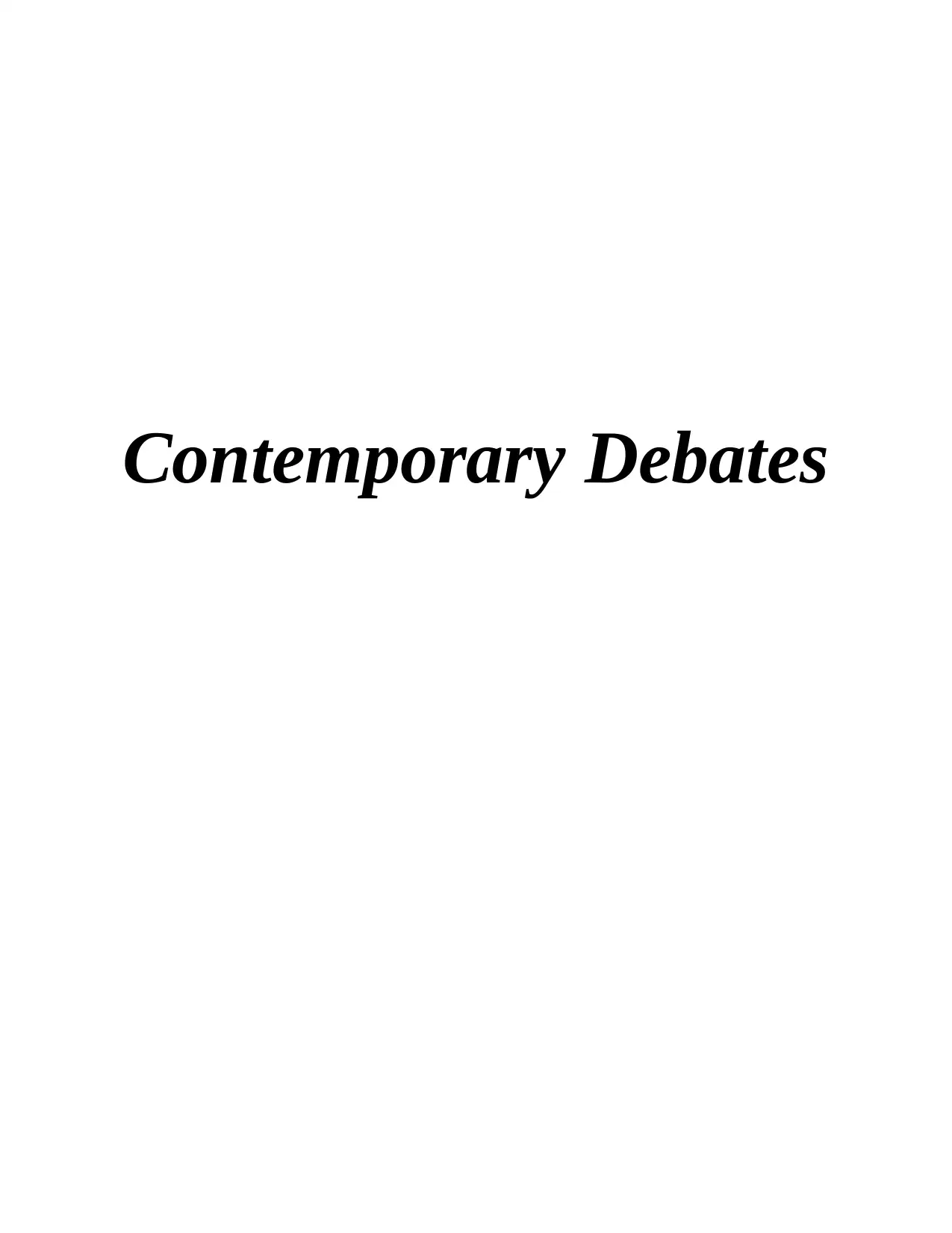
Contemporary Debates
Secure Best Marks with AI Grader
Need help grading? Try our AI Grader for instant feedback on your assignments.
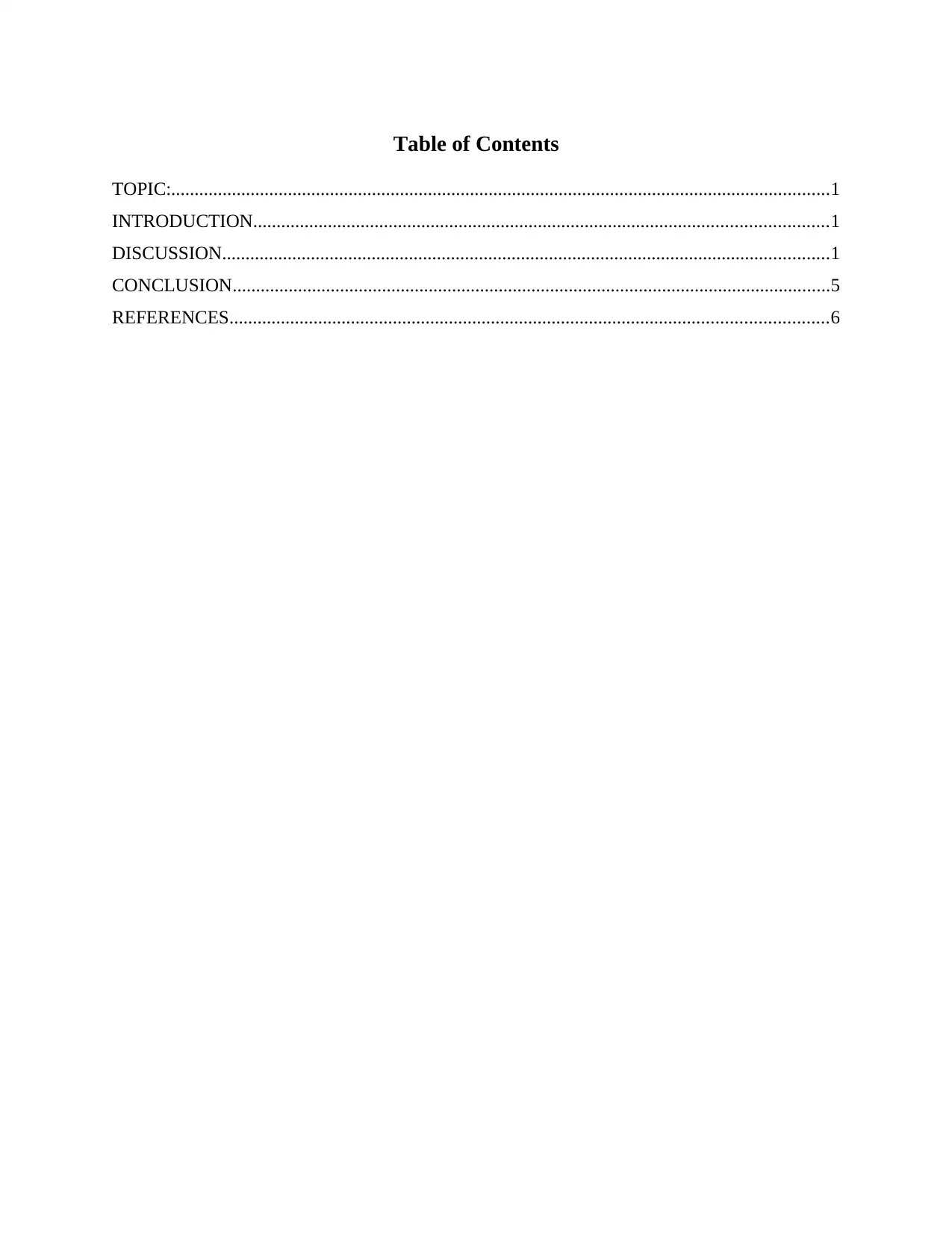
Table of Contents
TOPIC:.............................................................................................................................................1
INTRODUCTION...........................................................................................................................1
DISCUSSION..................................................................................................................................1
CONCLUSION................................................................................................................................5
REFERENCES................................................................................................................................6
TOPIC:.............................................................................................................................................1
INTRODUCTION...........................................................................................................................1
DISCUSSION..................................................................................................................................1
CONCLUSION................................................................................................................................5
REFERENCES................................................................................................................................6
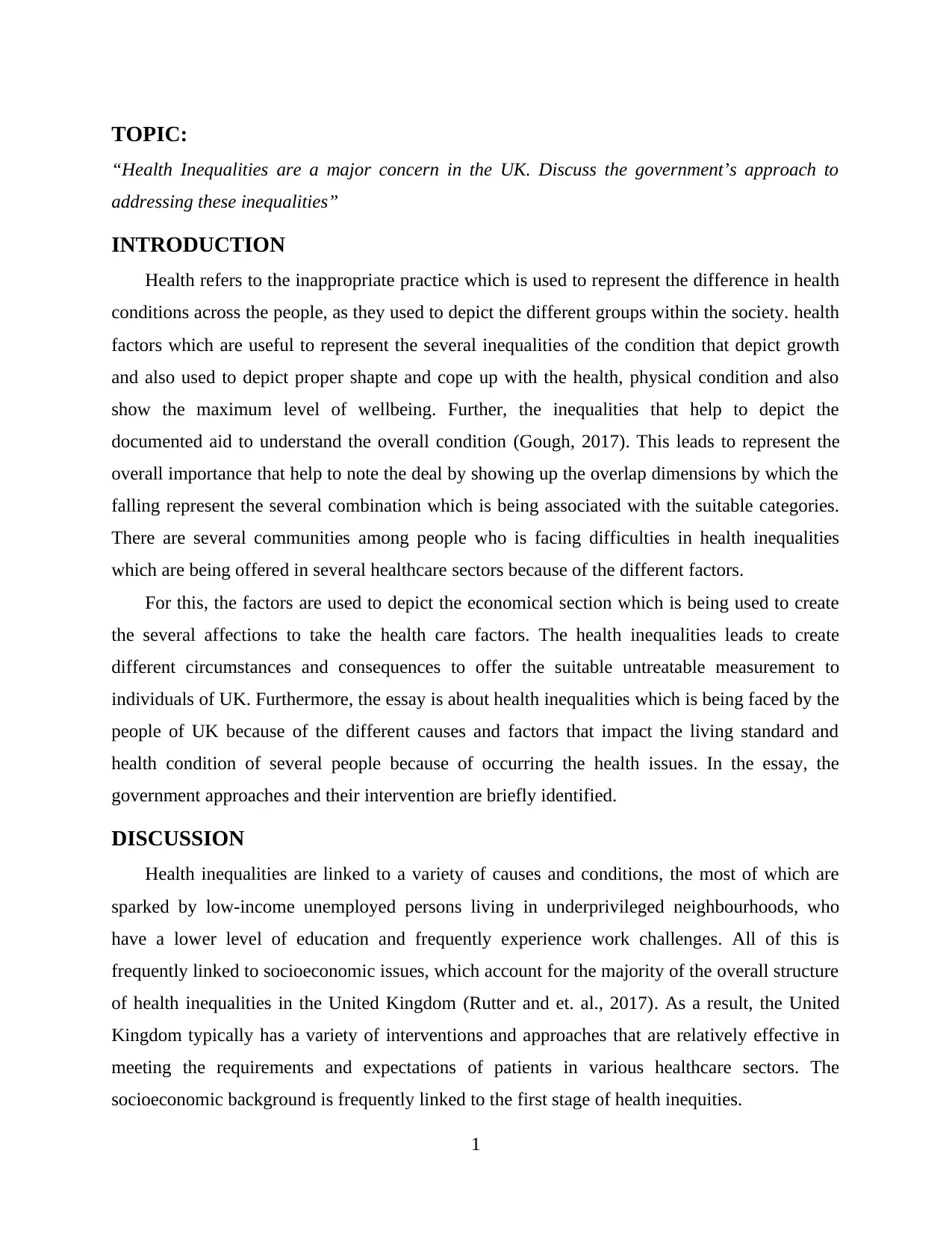
TOPIC:
“Health Inequalities are a major concern in the UK. Discuss the government’s approach to
addressing these inequalities”
INTRODUCTION
Health refers to the inappropriate practice which is used to represent the difference in health
conditions across the people, as they used to depict the different groups within the society. health
factors which are useful to represent the several inequalities of the condition that depict growth
and also used to depict proper shapte and cope up with the health, physical condition and also
show the maximum level of wellbeing. Further, the inequalities that help to depict the
documented aid to understand the overall condition (Gough, 2017). This leads to represent the
overall importance that help to note the deal by showing up the overlap dimensions by which the
falling represent the several combination which is being associated with the suitable categories.
There are several communities among people who is facing difficulties in health inequalities
which are being offered in several healthcare sectors because of the different factors.
For this, the factors are used to depict the economical section which is being used to create
the several affections to take the health care factors. The health inequalities leads to create
different circumstances and consequences to offer the suitable untreatable measurement to
individuals of UK. Furthermore, the essay is about health inequalities which is being faced by the
people of UK because of the different causes and factors that impact the living standard and
health condition of several people because of occurring the health issues. In the essay, the
government approaches and their intervention are briefly identified.
DISCUSSION
Health inequalities are linked to a variety of causes and conditions, the most of which are
sparked by low-income unemployed persons living in underprivileged neighbourhoods, who
have a lower level of education and frequently experience work challenges. All of this is
frequently linked to socioeconomic issues, which account for the majority of the overall structure
of health inequalities in the United Kingdom (Rutter and et. al., 2017). As a result, the United
Kingdom typically has a variety of interventions and approaches that are relatively effective in
meeting the requirements and expectations of patients in various healthcare sectors. The
socioeconomic background is frequently linked to the first stage of health inequities.
1
“Health Inequalities are a major concern in the UK. Discuss the government’s approach to
addressing these inequalities”
INTRODUCTION
Health refers to the inappropriate practice which is used to represent the difference in health
conditions across the people, as they used to depict the different groups within the society. health
factors which are useful to represent the several inequalities of the condition that depict growth
and also used to depict proper shapte and cope up with the health, physical condition and also
show the maximum level of wellbeing. Further, the inequalities that help to depict the
documented aid to understand the overall condition (Gough, 2017). This leads to represent the
overall importance that help to note the deal by showing up the overlap dimensions by which the
falling represent the several combination which is being associated with the suitable categories.
There are several communities among people who is facing difficulties in health inequalities
which are being offered in several healthcare sectors because of the different factors.
For this, the factors are used to depict the economical section which is being used to create
the several affections to take the health care factors. The health inequalities leads to create
different circumstances and consequences to offer the suitable untreatable measurement to
individuals of UK. Furthermore, the essay is about health inequalities which is being faced by the
people of UK because of the different causes and factors that impact the living standard and
health condition of several people because of occurring the health issues. In the essay, the
government approaches and their intervention are briefly identified.
DISCUSSION
Health inequalities are linked to a variety of causes and conditions, the most of which are
sparked by low-income unemployed persons living in underprivileged neighbourhoods, who
have a lower level of education and frequently experience work challenges. All of this is
frequently linked to socioeconomic issues, which account for the majority of the overall structure
of health inequalities in the United Kingdom (Rutter and et. al., 2017). As a result, the United
Kingdom typically has a variety of interventions and approaches that are relatively effective in
meeting the requirements and expectations of patients in various healthcare sectors. The
socioeconomic background is frequently linked to the first stage of health inequities.
1
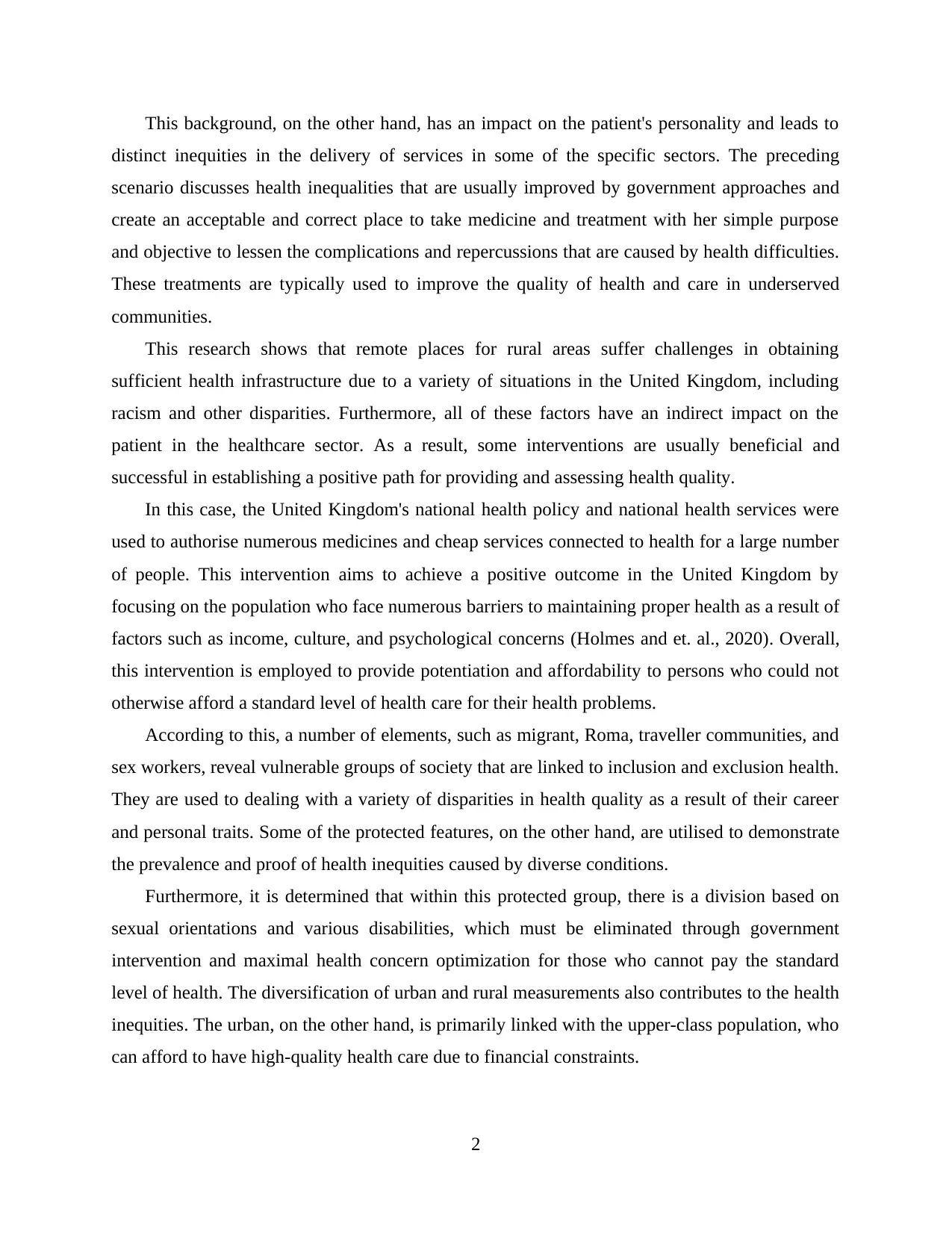
This background, on the other hand, has an impact on the patient's personality and leads to
distinct inequities in the delivery of services in some of the specific sectors. The preceding
scenario discusses health inequalities that are usually improved by government approaches and
create an acceptable and correct place to take medicine and treatment with her simple purpose
and objective to lessen the complications and repercussions that are caused by health difficulties.
These treatments are typically used to improve the quality of health and care in underserved
communities.
This research shows that remote places for rural areas suffer challenges in obtaining
sufficient health infrastructure due to a variety of situations in the United Kingdom, including
racism and other disparities. Furthermore, all of these factors have an indirect impact on the
patient in the healthcare sector. As a result, some interventions are usually beneficial and
successful in establishing a positive path for providing and assessing health quality.
In this case, the United Kingdom's national health policy and national health services were
used to authorise numerous medicines and cheap services connected to health for a large number
of people. This intervention aims to achieve a positive outcome in the United Kingdom by
focusing on the population who face numerous barriers to maintaining proper health as a result of
factors such as income, culture, and psychological concerns (Holmes and et. al., 2020). Overall,
this intervention is employed to provide potentiation and affordability to persons who could not
otherwise afford a standard level of health care for their health problems.
According to this, a number of elements, such as migrant, Roma, traveller communities, and
sex workers, reveal vulnerable groups of society that are linked to inclusion and exclusion health.
They are used to dealing with a variety of disparities in health quality as a result of their career
and personal traits. Some of the protected features, on the other hand, are utilised to demonstrate
the prevalence and proof of health inequities caused by diverse conditions.
Furthermore, it is determined that within this protected group, there is a division based on
sexual orientations and various disabilities, which must be eliminated through government
intervention and maximal health concern optimization for those who cannot pay the standard
level of health. The diversification of urban and rural measurements also contributes to the health
inequities. The urban, on the other hand, is primarily linked with the upper-class population, who
can afford to have high-quality health care due to financial constraints.
2
distinct inequities in the delivery of services in some of the specific sectors. The preceding
scenario discusses health inequalities that are usually improved by government approaches and
create an acceptable and correct place to take medicine and treatment with her simple purpose
and objective to lessen the complications and repercussions that are caused by health difficulties.
These treatments are typically used to improve the quality of health and care in underserved
communities.
This research shows that remote places for rural areas suffer challenges in obtaining
sufficient health infrastructure due to a variety of situations in the United Kingdom, including
racism and other disparities. Furthermore, all of these factors have an indirect impact on the
patient in the healthcare sector. As a result, some interventions are usually beneficial and
successful in establishing a positive path for providing and assessing health quality.
In this case, the United Kingdom's national health policy and national health services were
used to authorise numerous medicines and cheap services connected to health for a large number
of people. This intervention aims to achieve a positive outcome in the United Kingdom by
focusing on the population who face numerous barriers to maintaining proper health as a result of
factors such as income, culture, and psychological concerns (Holmes and et. al., 2020). Overall,
this intervention is employed to provide potentiation and affordability to persons who could not
otherwise afford a standard level of health care for their health problems.
According to this, a number of elements, such as migrant, Roma, traveller communities, and
sex workers, reveal vulnerable groups of society that are linked to inclusion and exclusion health.
They are used to dealing with a variety of disparities in health quality as a result of their career
and personal traits. Some of the protected features, on the other hand, are utilised to demonstrate
the prevalence and proof of health inequities caused by diverse conditions.
Furthermore, it is determined that within this protected group, there is a division based on
sexual orientations and various disabilities, which must be eliminated through government
intervention and maximal health concern optimization for those who cannot pay the standard
level of health. The diversification of urban and rural measurements also contributes to the health
inequities. The urban, on the other hand, is primarily linked with the upper-class population, who
can afford to have high-quality health care due to financial constraints.
2
Secure Best Marks with AI Grader
Need help grading? Try our AI Grader for instant feedback on your assignments.
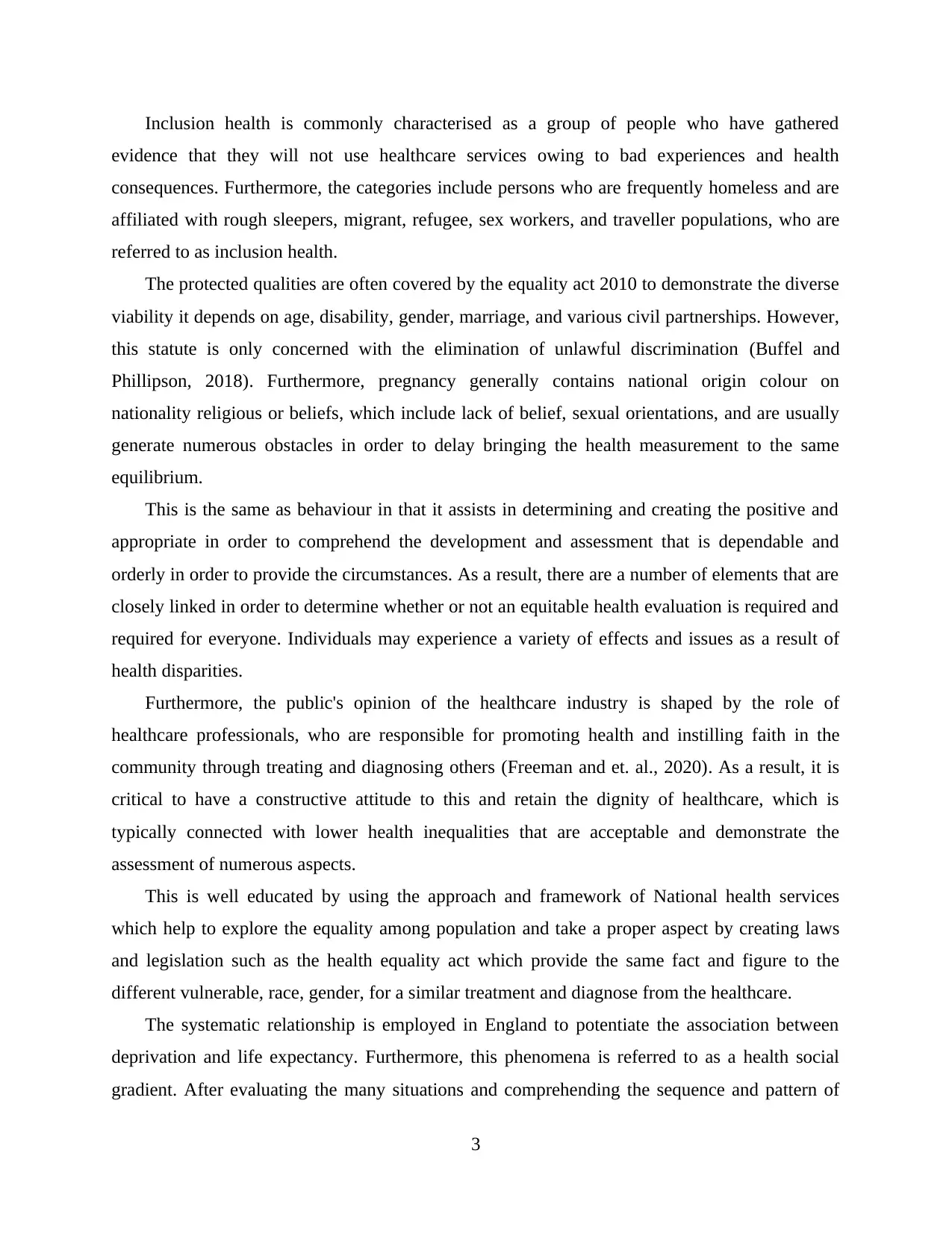
Inclusion health is commonly characterised as a group of people who have gathered
evidence that they will not use healthcare services owing to bad experiences and health
consequences. Furthermore, the categories include persons who are frequently homeless and are
affiliated with rough sleepers, migrant, refugee, sex workers, and traveller populations, who are
referred to as inclusion health.
The protected qualities are often covered by the equality act 2010 to demonstrate the diverse
viability it depends on age, disability, gender, marriage, and various civil partnerships. However,
this statute is only concerned with the elimination of unlawful discrimination (Buffel and
Phillipson, 2018). Furthermore, pregnancy generally contains national origin colour on
nationality religious or beliefs, which include lack of belief, sexual orientations, and are usually
generate numerous obstacles in order to delay bringing the health measurement to the same
equilibrium.
This is the same as behaviour in that it assists in determining and creating the positive and
appropriate in order to comprehend the development and assessment that is dependable and
orderly in order to provide the circumstances. As a result, there are a number of elements that are
closely linked in order to determine whether or not an equitable health evaluation is required and
required for everyone. Individuals may experience a variety of effects and issues as a result of
health disparities.
Furthermore, the public's opinion of the healthcare industry is shaped by the role of
healthcare professionals, who are responsible for promoting health and instilling faith in the
community through treating and diagnosing others (Freeman and et. al., 2020). As a result, it is
critical to have a constructive attitude to this and retain the dignity of healthcare, which is
typically connected with lower health inequalities that are acceptable and demonstrate the
assessment of numerous aspects.
This is well educated by using the approach and framework of National health services
which help to explore the equality among population and take a proper aspect by creating laws
and legislation such as the health equality act which provide the same fact and figure to the
different vulnerable, race, gender, for a similar treatment and diagnose from the healthcare.
The systematic relationship is employed in England to potentiate the association between
deprivation and life expectancy. Furthermore, this phenomena is referred to as a health social
gradient. After evaluating the many situations and comprehending the sequence and pattern of
3
evidence that they will not use healthcare services owing to bad experiences and health
consequences. Furthermore, the categories include persons who are frequently homeless and are
affiliated with rough sleepers, migrant, refugee, sex workers, and traveller populations, who are
referred to as inclusion health.
The protected qualities are often covered by the equality act 2010 to demonstrate the diverse
viability it depends on age, disability, gender, marriage, and various civil partnerships. However,
this statute is only concerned with the elimination of unlawful discrimination (Buffel and
Phillipson, 2018). Furthermore, pregnancy generally contains national origin colour on
nationality religious or beliefs, which include lack of belief, sexual orientations, and are usually
generate numerous obstacles in order to delay bringing the health measurement to the same
equilibrium.
This is the same as behaviour in that it assists in determining and creating the positive and
appropriate in order to comprehend the development and assessment that is dependable and
orderly in order to provide the circumstances. As a result, there are a number of elements that are
closely linked in order to determine whether or not an equitable health evaluation is required and
required for everyone. Individuals may experience a variety of effects and issues as a result of
health disparities.
Furthermore, the public's opinion of the healthcare industry is shaped by the role of
healthcare professionals, who are responsible for promoting health and instilling faith in the
community through treating and diagnosing others (Freeman and et. al., 2020). As a result, it is
critical to have a constructive attitude to this and retain the dignity of healthcare, which is
typically connected with lower health inequalities that are acceptable and demonstrate the
assessment of numerous aspects.
This is well educated by using the approach and framework of National health services
which help to explore the equality among population and take a proper aspect by creating laws
and legislation such as the health equality act which provide the same fact and figure to the
different vulnerable, race, gender, for a similar treatment and diagnose from the healthcare.
The systematic relationship is employed in England to potentiate the association between
deprivation and life expectancy. Furthermore, this phenomena is referred to as a health social
gradient. After evaluating the many situations and comprehending the sequence and pattern of
3
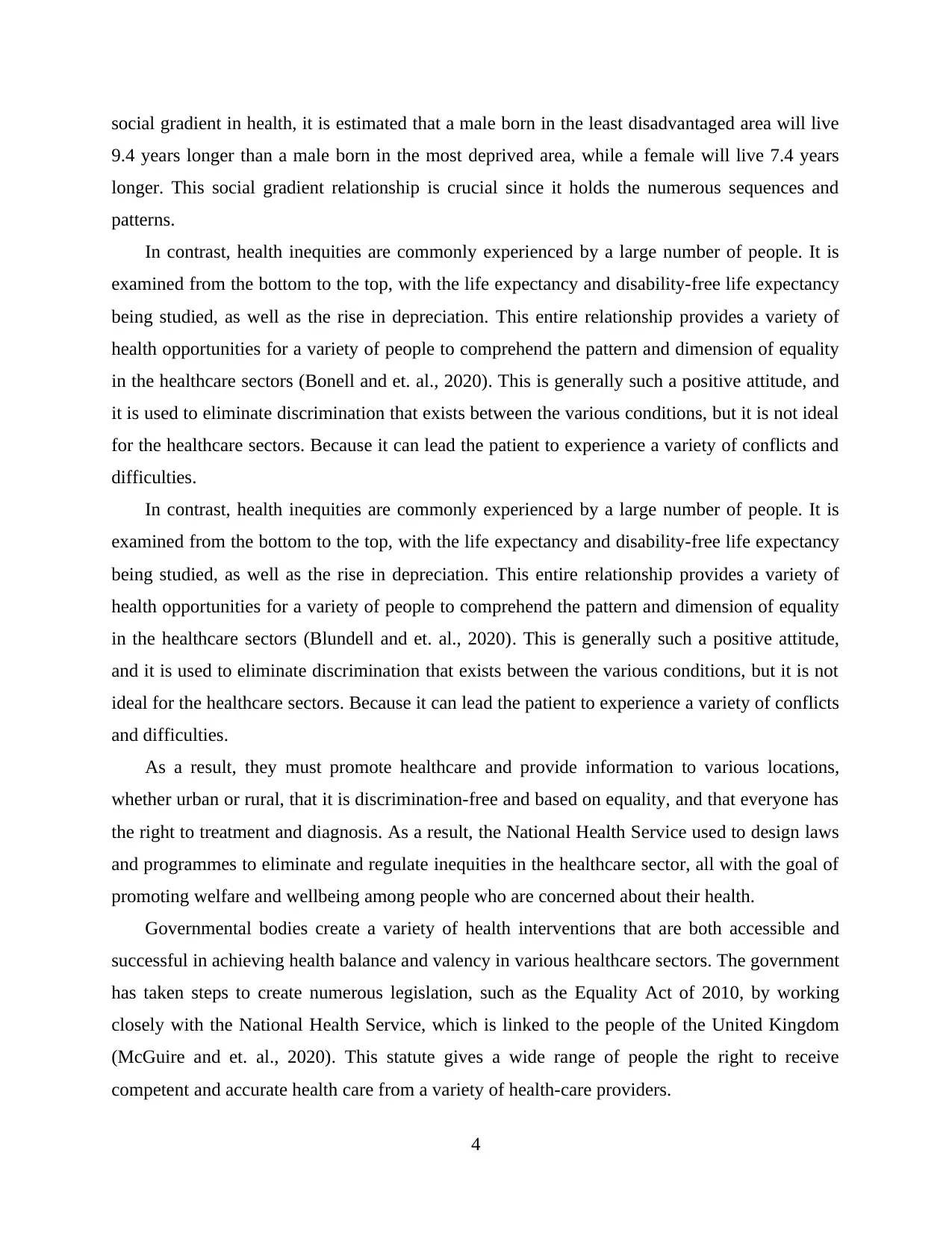
social gradient in health, it is estimated that a male born in the least disadvantaged area will live
9.4 years longer than a male born in the most deprived area, while a female will live 7.4 years
longer. This social gradient relationship is crucial since it holds the numerous sequences and
patterns.
In contrast, health inequities are commonly experienced by a large number of people. It is
examined from the bottom to the top, with the life expectancy and disability-free life expectancy
being studied, as well as the rise in depreciation. This entire relationship provides a variety of
health opportunities for a variety of people to comprehend the pattern and dimension of equality
in the healthcare sectors (Bonell and et. al., 2020). This is generally such a positive attitude, and
it is used to eliminate discrimination that exists between the various conditions, but it is not ideal
for the healthcare sectors. Because it can lead the patient to experience a variety of conflicts and
difficulties.
In contrast, health inequities are commonly experienced by a large number of people. It is
examined from the bottom to the top, with the life expectancy and disability-free life expectancy
being studied, as well as the rise in depreciation. This entire relationship provides a variety of
health opportunities for a variety of people to comprehend the pattern and dimension of equality
in the healthcare sectors (Blundell and et. al., 2020). This is generally such a positive attitude,
and it is used to eliminate discrimination that exists between the various conditions, but it is not
ideal for the healthcare sectors. Because it can lead the patient to experience a variety of conflicts
and difficulties.
As a result, they must promote healthcare and provide information to various locations,
whether urban or rural, that it is discrimination-free and based on equality, and that everyone has
the right to treatment and diagnosis. As a result, the National Health Service used to design laws
and programmes to eliminate and regulate inequities in the healthcare sector, all with the goal of
promoting welfare and wellbeing among people who are concerned about their health.
Governmental bodies create a variety of health interventions that are both accessible and
successful in achieving health balance and valency in various healthcare sectors. The government
has taken steps to create numerous legislation, such as the Equality Act of 2010, by working
closely with the National Health Service, which is linked to the people of the United Kingdom
(McGuire and et. al., 2020). This statute gives a wide range of people the right to receive
competent and accurate health care from a variety of health-care providers.
4
9.4 years longer than a male born in the most deprived area, while a female will live 7.4 years
longer. This social gradient relationship is crucial since it holds the numerous sequences and
patterns.
In contrast, health inequities are commonly experienced by a large number of people. It is
examined from the bottom to the top, with the life expectancy and disability-free life expectancy
being studied, as well as the rise in depreciation. This entire relationship provides a variety of
health opportunities for a variety of people to comprehend the pattern and dimension of equality
in the healthcare sectors (Bonell and et. al., 2020). This is generally such a positive attitude, and
it is used to eliminate discrimination that exists between the various conditions, but it is not ideal
for the healthcare sectors. Because it can lead the patient to experience a variety of conflicts and
difficulties.
In contrast, health inequities are commonly experienced by a large number of people. It is
examined from the bottom to the top, with the life expectancy and disability-free life expectancy
being studied, as well as the rise in depreciation. This entire relationship provides a variety of
health opportunities for a variety of people to comprehend the pattern and dimension of equality
in the healthcare sectors (Blundell and et. al., 2020). This is generally such a positive attitude,
and it is used to eliminate discrimination that exists between the various conditions, but it is not
ideal for the healthcare sectors. Because it can lead the patient to experience a variety of conflicts
and difficulties.
As a result, they must promote healthcare and provide information to various locations,
whether urban or rural, that it is discrimination-free and based on equality, and that everyone has
the right to treatment and diagnosis. As a result, the National Health Service used to design laws
and programmes to eliminate and regulate inequities in the healthcare sector, all with the goal of
promoting welfare and wellbeing among people who are concerned about their health.
Governmental bodies create a variety of health interventions that are both accessible and
successful in achieving health balance and valency in various healthcare sectors. The government
has taken steps to create numerous legislation, such as the Equality Act of 2010, by working
closely with the National Health Service, which is linked to the people of the United Kingdom
(McGuire and et. al., 2020). This statute gives a wide range of people the right to receive
competent and accurate health care from a variety of health-care providers.
4
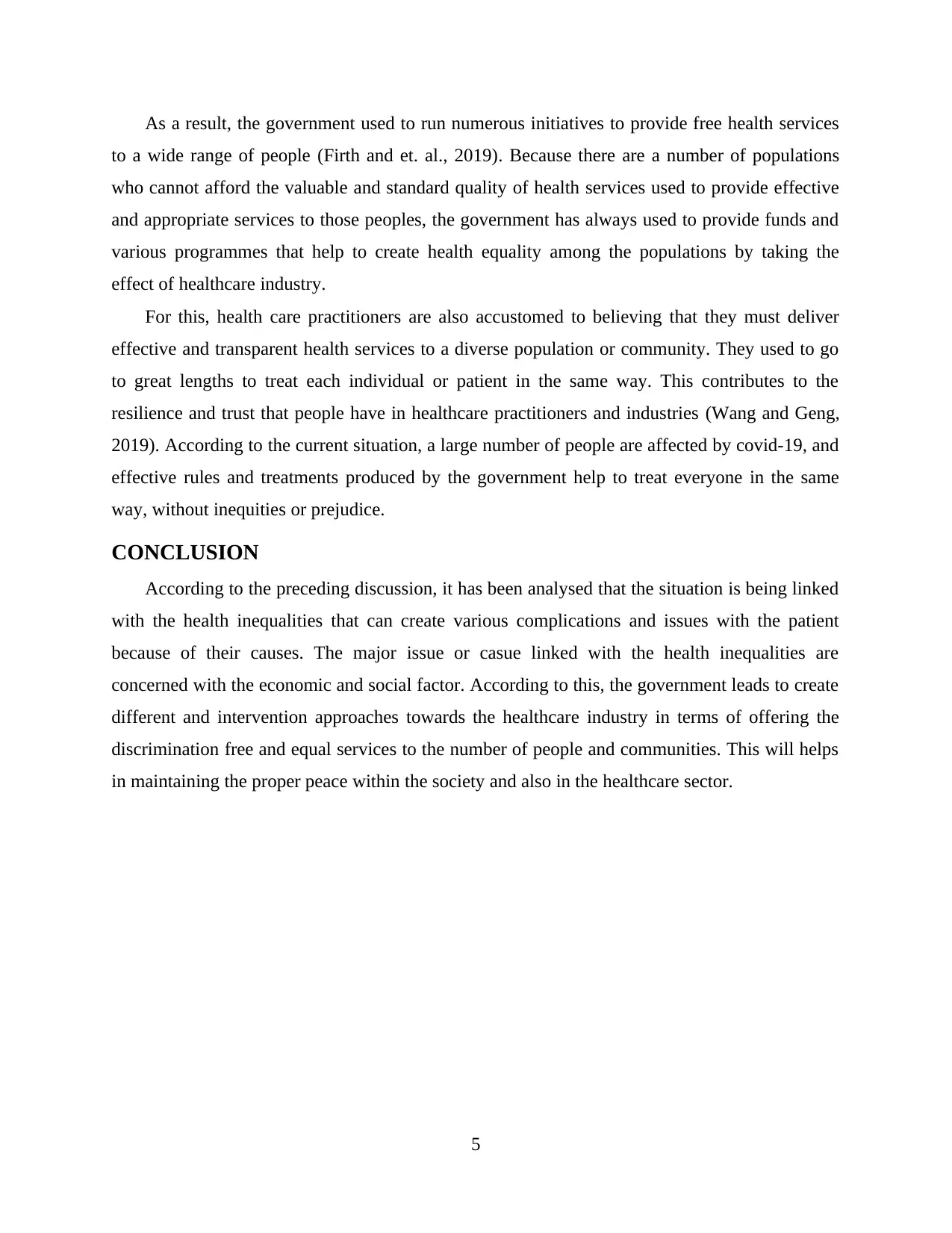
As a result, the government used to run numerous initiatives to provide free health services
to a wide range of people (Firth and et. al., 2019). Because there are a number of populations
who cannot afford the valuable and standard quality of health services used to provide effective
and appropriate services to those peoples, the government has always used to provide funds and
various programmes that help to create health equality among the populations by taking the
effect of healthcare industry.
For this, health care practitioners are also accustomed to believing that they must deliver
effective and transparent health services to a diverse population or community. They used to go
to great lengths to treat each individual or patient in the same way. This contributes to the
resilience and trust that people have in healthcare practitioners and industries (Wang and Geng,
2019). According to the current situation, a large number of people are affected by covid-19, and
effective rules and treatments produced by the government help to treat everyone in the same
way, without inequities or prejudice.
CONCLUSION
According to the preceding discussion, it has been analysed that the situation is being linked
with the health inequalities that can create various complications and issues with the patient
because of their causes. The major issue or casue linked with the health inequalities are
concerned with the economic and social factor. According to this, the government leads to create
different and intervention approaches towards the healthcare industry in terms of offering the
discrimination free and equal services to the number of people and communities. This will helps
in maintaining the proper peace within the society and also in the healthcare sector.
5
to a wide range of people (Firth and et. al., 2019). Because there are a number of populations
who cannot afford the valuable and standard quality of health services used to provide effective
and appropriate services to those peoples, the government has always used to provide funds and
various programmes that help to create health equality among the populations by taking the
effect of healthcare industry.
For this, health care practitioners are also accustomed to believing that they must deliver
effective and transparent health services to a diverse population or community. They used to go
to great lengths to treat each individual or patient in the same way. This contributes to the
resilience and trust that people have in healthcare practitioners and industries (Wang and Geng,
2019). According to the current situation, a large number of people are affected by covid-19, and
effective rules and treatments produced by the government help to treat everyone in the same
way, without inequities or prejudice.
CONCLUSION
According to the preceding discussion, it has been analysed that the situation is being linked
with the health inequalities that can create various complications and issues with the patient
because of their causes. The major issue or casue linked with the health inequalities are
concerned with the economic and social factor. According to this, the government leads to create
different and intervention approaches towards the healthcare industry in terms of offering the
discrimination free and equal services to the number of people and communities. This will helps
in maintaining the proper peace within the society and also in the healthcare sector.
5
Paraphrase This Document
Need a fresh take? Get an instant paraphrase of this document with our AI Paraphraser
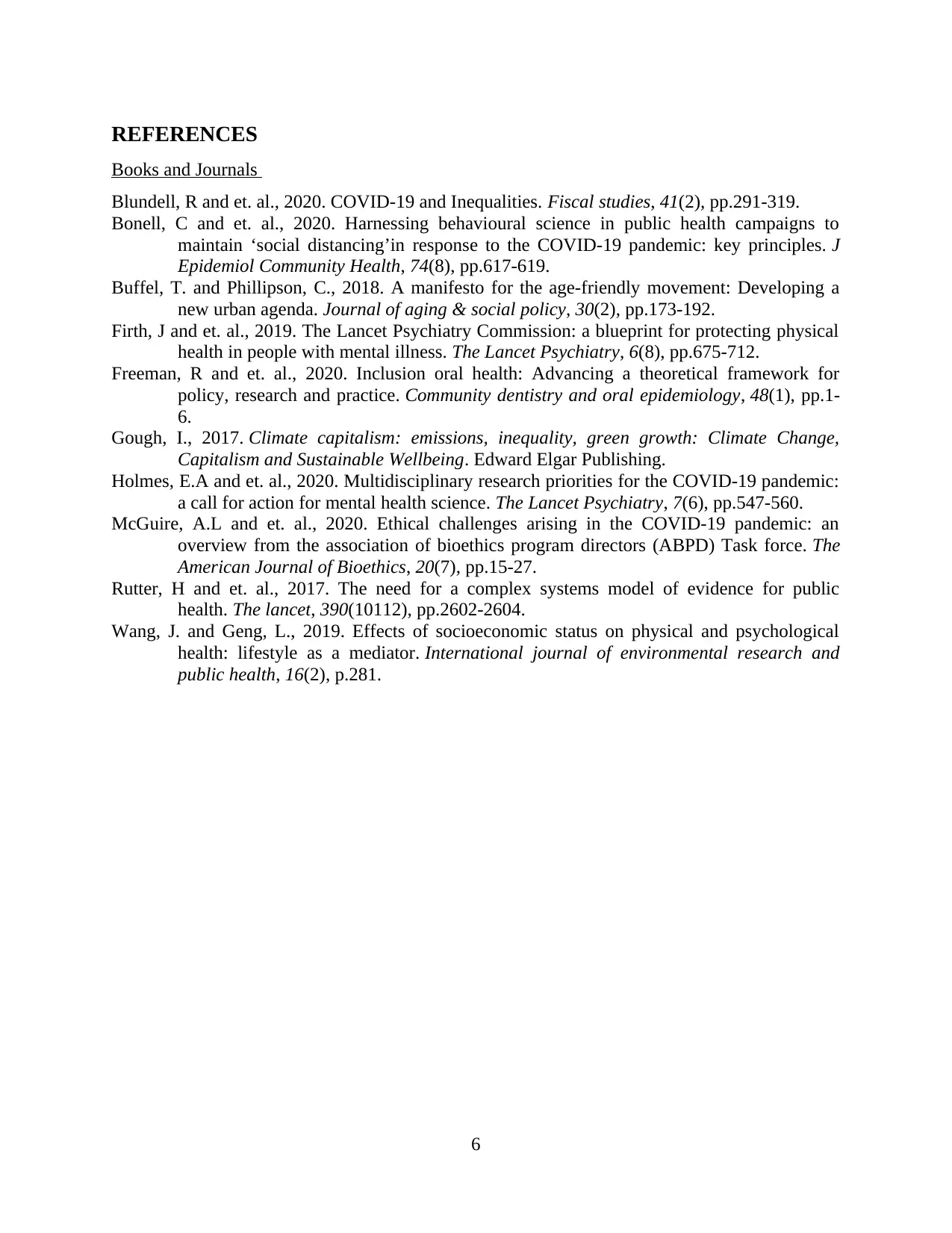
REFERENCES
Books and Journals
Blundell, R and et. al., 2020. COVID‐19 and Inequalities. Fiscal studies, 41(2), pp.291-319.
Bonell, C and et. al., 2020. Harnessing behavioural science in public health campaigns to
maintain ‘social distancing’in response to the COVID-19 pandemic: key principles. J
Epidemiol Community Health, 74(8), pp.617-619.
Buffel, T. and Phillipson, C., 2018. A manifesto for the age-friendly movement: Developing a
new urban agenda. Journal of aging & social policy, 30(2), pp.173-192.
Firth, J and et. al., 2019. The Lancet Psychiatry Commission: a blueprint for protecting physical
health in people with mental illness. The Lancet Psychiatry, 6(8), pp.675-712.
Freeman, R and et. al., 2020. Inclusion oral health: Advancing a theoretical framework for
policy, research and practice. Community dentistry and oral epidemiology, 48(1), pp.1-
6.
Gough, I., 2017. Climate capitalism: emissions, inequality, green growth: Climate Change,
Capitalism and Sustainable Wellbeing. Edward Elgar Publishing.
Holmes, E.A and et. al., 2020. Multidisciplinary research priorities for the COVID-19 pandemic:
a call for action for mental health science. The Lancet Psychiatry, 7(6), pp.547-560.
McGuire, A.L and et. al., 2020. Ethical challenges arising in the COVID-19 pandemic: an
overview from the association of bioethics program directors (ABPD) Task force. The
American Journal of Bioethics, 20(7), pp.15-27.
Rutter, H and et. al., 2017. The need for a complex systems model of evidence for public
health. The lancet, 390(10112), pp.2602-2604.
Wang, J. and Geng, L., 2019. Effects of socioeconomic status on physical and psychological
health: lifestyle as a mediator. International journal of environmental research and
public health, 16(2), p.281.
6
Books and Journals
Blundell, R and et. al., 2020. COVID‐19 and Inequalities. Fiscal studies, 41(2), pp.291-319.
Bonell, C and et. al., 2020. Harnessing behavioural science in public health campaigns to
maintain ‘social distancing’in response to the COVID-19 pandemic: key principles. J
Epidemiol Community Health, 74(8), pp.617-619.
Buffel, T. and Phillipson, C., 2018. A manifesto for the age-friendly movement: Developing a
new urban agenda. Journal of aging & social policy, 30(2), pp.173-192.
Firth, J and et. al., 2019. The Lancet Psychiatry Commission: a blueprint for protecting physical
health in people with mental illness. The Lancet Psychiatry, 6(8), pp.675-712.
Freeman, R and et. al., 2020. Inclusion oral health: Advancing a theoretical framework for
policy, research and practice. Community dentistry and oral epidemiology, 48(1), pp.1-
6.
Gough, I., 2017. Climate capitalism: emissions, inequality, green growth: Climate Change,
Capitalism and Sustainable Wellbeing. Edward Elgar Publishing.
Holmes, E.A and et. al., 2020. Multidisciplinary research priorities for the COVID-19 pandemic:
a call for action for mental health science. The Lancet Psychiatry, 7(6), pp.547-560.
McGuire, A.L and et. al., 2020. Ethical challenges arising in the COVID-19 pandemic: an
overview from the association of bioethics program directors (ABPD) Task force. The
American Journal of Bioethics, 20(7), pp.15-27.
Rutter, H and et. al., 2017. The need for a complex systems model of evidence for public
health. The lancet, 390(10112), pp.2602-2604.
Wang, J. and Geng, L., 2019. Effects of socioeconomic status on physical and psychological
health: lifestyle as a mediator. International journal of environmental research and
public health, 16(2), p.281.
6
1 out of 8
Related Documents
Your All-in-One AI-Powered Toolkit for Academic Success.
+13062052269
info@desklib.com
Available 24*7 on WhatsApp / Email
![[object Object]](/_next/static/media/star-bottom.7253800d.svg)
Unlock your academic potential
© 2024 | Zucol Services PVT LTD | All rights reserved.




